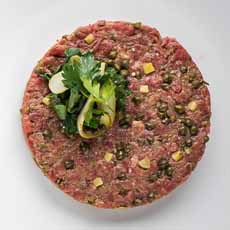TIP OF THE DAY: Create A Signature Tartare Recipe
 [1] Strawberry and beet “tartare.” On top of the ice cream is a cloud of cotton candy (photo courtesy Ananda Restaurant).
|
Language evolves, of course. The meaning of words change over time, or grow to encompass additional meanings (although we hope that won’t happen with “woke”). It’s no different in culinary language, especially given the march of creativity and innovation. Take the classic Steak Tartare, known for more than 100 years as ground raw beef mixed with onions, capers, Worcestershire sauce and a raw egg. While 20 years ago, a dish called “tartare” was finely-diced meat (photo #3), or subsequently fish (see the history of steak tartare, below), today anything mounded in a small dice is being called “tartare.” Eleven Madison Park restaurant in New York City pioneered an exciting Carrot Tartare; whole carrots go through a meat grinder at the table (check it out). You can even make tartare for dessert, as in today’s recipe for Strawberry & Beet Tartare (photo #1). Or, make a vegetable tartare like Carrot Tartare (photo #2). In today’s fashion, if you can dice it, season it and mound it, you’ve got tartare! Ingredients This recipe is adapted from one on French Women Don’t Get Fat. |
|
|
Preparation 1. PLACE the beets at bottom of a salad bowl and sprinkle with sugar. Add the strawberries and sprinkle with sugar. 2. ADD the basil and refrigerate for a few hours or overnight. 3. MOUND on a plate; use a ring mold if you have one. Garnish as desired. Steak tartare, or tartar steak*, is ground raw beef mixed with onions, capers, Worcestershire sauce and a raw egg. It is generally served with toast points. In Belgium, where the dish is popular and served with frites (French fries), it is known as filet américain. The ancestor of this raw meat dish was first described in print in 1660, in a book by a French engineer, a visitor to the Ukraine. Ukrainian Cossacks, he wrote, put finger-thick slices of salted raw horse meat under their saddles and rode their horses until the salted meat was drained of its blood. They then thinly sliced and ate it (source). The modern version of what became known as Steak Tartare, with raw egg, was first served in French restaurants early in the 20th century. It was then called Steack à l’Americaine. The 1921 edition of Escoffier’s Le Guide Culinaire defines Steack à l’Americaine as made without egg yolk, and served with tartar sauce on the side. Modern steak tartare is an evolution of that dish. The 1938 edition of Larousse Gastronomique describes steak tartare as raw ground beef served with a raw egg yolk, with no mention of tartar sauce (source). In the U.S., the dish is often called Steak Tartare, “steak” having more appeal than the more generic “beef.” We’ve had lamb tartare more than a few times, at high-end restaurants. The name “tartare” is now applied to other meats or fish, such as tuna tartare, which introduced in 1975 by the Parisian restaurant Le Duc in Paris. “À la tartare” or simply “tartare” still means “served with tartar sauce” for some dishes, particularly fried fish. ________________ *The dish is often attributed to Genghis Khan and the Tatars, who may have originated the horseback recipe. The explanation is that the Tatars, on the rampage, did not have time to cook their meat. |
||




